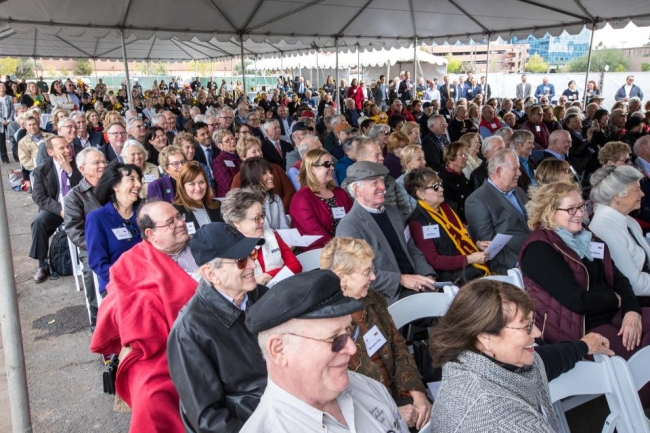You have /5 articles left.
Sign up for a free account or log in.

Future residents and guests watch the groundbreaking ceremony of ASU Mirabella in February 2018.
Charlie Leight/ASU Now
New housing under construction at Arizona State University isn't slated to be completed until 2020, but the university president has nonetheless dubbed it "the world's coolest dorm," and future residents have already secured their spots.
The residents won’t be typical college students, however -- they’ll be people in their 60s, 70s and up. The housing complex on the university’s Tempe campus will be a retirement community with a twist -- the residents will be able to take classes, make use of campus facilities such as the library with university-issued ID cards and immerse themselves in university life as much, or as little, as they like. They'll also be encouraged to mentor and build relationships with younger students.
“There’s no reason everyone can’t be a college student and engaged in what this community has to offer for the entirety of their lives,” ASU president Michael Crow said at a groundbreaking ceremony for the complex, called ASU Mirabella, in February 2018. “We’re excited that we’ll have on our campus several hundred new learners, new teachers and new experts,” he said.
Crow said he wants to reconceptualize "lifelong learning," a popular talking point among university leaders who promote the important role of higher education in helping adults prepare for new career opportunities. Retirees are often left out of the equation and have not been a significant part of those efforts, said Todd Hardy, managing director of innovation zones at ASU. While they don’t need degrees or certificates to show to future employers, many retirees do want to keep learning and feel engaged, he said.
“We want these residents to be part of our community and to be fully integrated into everything we do,” Hardy said “We’d like them to be guest lecturers, advise us on start-up companies, be docents at our art gallery and performance hall. We’d love them to engage in ways that appeal to them.”
Mirabella residents could even help shape academic programs and research at ASU, he said. Areas of collaboration might include art therapy, Alzheimer’s treatment, nursing and online education. ASU is even considering whether students could work with Mirabella residents as part of their coursework.
ASU is part of a growing trend of privately owned retirement communities being built on or near college campuses.
Ramona Meraz Lewis, a faculty coordinator at the College of Education and Human Development at Western Michigan University who has conducted research on older learners, said ASU Mirabella is an “innovative take on a somewhat established idea.”
While some of these retirement communities may lease or buy college-owned land, such as Kendal at Oberlin, which has close ties to Oberlin College in northern Ohio, and Vi at Palo Alto near Stanford University, very few are actually situated on a campus, she said. Some communities, such as Oak Hammock at the University of Florida or University Commons at the University of Michigan, have deep connections to the universities and were even founded by former faculty. But neither community is directly managed by the universities.
Lasell College, a private institution in Auburndale, Mass., shares a 13-acre site with a retirement community called Lasell Village. To be a resident at Lasell Village, residents must commit to taking at least 450 hours of learning and fitness classes each year, including attending lectures with regular students pursuing degrees.
“With the U.S. on the brink of an ‘elderly boom,’ finding ways to engage older learners in the life of campus is a smart idea,” said Lewis.
“Demographic changes have led many retirees and senior citizens to rethink the postretirement life phase. The new trends suggest older learners have a great interest in staying active, intergenerational opportunities and lifelong learning.
“The human resource in terms of energy, experience and time that older adults are often willing to contribute is a win-win for the individual, the campus and the students,” she said.
Still, Lewis said higher education leaders could do a lot more to promote “age as a function of diversity.”
“One of the most important factors in quality of life as we age is avoiding social isolation. If our campuses can be a part of this in ways that enrich the lives of our students, our alumni, our retirees and our larger communities -- then we should be open to those opportunities,” she said.
According to the National Center for Education Statistics, just 0.3 percent of students pursuing a degree are aged 65 and over. And education programs targeting those aged 55 and older rarely generate significant long-term revenues, according to Jim Fong, founding director of the University Professional and Continuing Education Association’s Center for Research and Strategy.
“The target market is conditioned to not want to pay for much in terms of educational programming,” he said.
However, demand for educational programs from older learners is increasing, said Rovy Branon, vice provost for the University of Washington's Continuum College in Seattle.
Many universities provide enrichment opportunities for older learners, such as free lectures, but Branon said he's seeing “a trend towards more serious academic pursuits."
"Older people aren’t necessarily interested in getting a degree or diploma, but they are interested in doing serious study as part of their retirement, and some are even retooling for a third or fourth-act career," he said.
As Americans' life spans increase and people stay healthier longer, universities need to adapt, said Branon, who described the challenges and opportunities of the “60-year curriculum” -- a concept coined by Gary Matkin, dean of the Division of Continuing Education at the University of California, Irvine, which describes a continuous learning program from high school to retirement -- in an op-ed column he wrote for Inside Higher Ed in November.
Seth Meisel, associate dean of academic affairs at Northwestern University, said although many university administrators are starting to talk more about the 60-year curriculum, they will need to carefully consider the specific needs of older learners -- an area of pedagogy known as gerogogy. Classes "need to be in a location that is accessible and flexible," he said. Older learners also often have a lot of experience and want that to be acknowledged. "They want a learning environment that builds upon their experience," he said.
The National Resource Center for Osher Lifelong Learning Institutes -- a network offering lifelong learning opportunities to senior citizens -- is based at Northwestern. The 122, soon to be 123, college and university-based institutes offer noncredit courses for affordable prices. These courses "are not generally cash cows," said Meisel. But the network is growing and is popular with older learners. "There is an influx of retired people looking for meaning and purpose and engagement in their lives," he said.
"They're not looking for the validation of a degree -- in many cases, they're interested in areas they feel were neglected in their education," said Meisel. "There are engineers who want to learn about the humanities and arts, or vice versa."
Back to College, Again
Tom and Pat Gagen, a married couple in their 60s and future residents of ASU Mirabella, said they became interested in living on a university campus after seeing an ad for ASU Mirabella in a newspaper.
“We wanted a style of living that would provide for continued learning, for social encounters, worry-free living arrangements, and access to several levels of health care should we need it,” the Gagens said in a joint email.
The Gagens retired in 2012 and currently live in Scottsdale, Ariz. They don’t have any formal connection to ASU but are women’s softball season ticket holders and enjoy attending other events on campus.
Tom, a former health-care executive who was CEO of the Sutter Medical Center in Sacramento, and Pat, a former geriatric social worker who later worked in the insurance industry, both said they don't want to earn any more degrees, but they are interested in auditing classes and mentoring students.
“We are very excited about being in a learning environment with access to the university and its many resources. We want to take full use of the arts, the sports, the lectures and special events, and the whole campus environment,” they wrote. “We want to experience others our age and learn from their lives as well as from students.”
Activities that mix students and seniors “strengthen us as a community and help to minimize some of the wrong impressions that both the young and seniors may have,” they wrote. They would like to see other universities make more effort to engage with seniors.
“First, we still have a lot to offer. Second, we still have a lot to learn,” they said.
Living at ASU Mirabella doesn’t come cheap. Residents pay a “buy-in” fee starting at $378,500 for a one-bedroom unit and up to $810,200 for a two-bedroom penthouse. Residents also pay a monthly fee of between $4,195 and $5,570. When residents die, 85 percent of the buy-in fee is refunded to their heirs.
Despite the high cost, ASU Mirabella has already sold out. Residents like the idea of being part of a university community, even if they don’t have any connection to the institution, said Paul Riepma, senior vice president of sales and marketing for Pacific Retirement Services, an Oregon-based nonprofit that is leading the development of the complex.
The 20-story building will contain 304 apartments and cater to residents with varying health needs -- from independent living to round-the-clock care. In addition to fine and casual dining rooms, the complex will have a cocktail lounge, a fitness and aquatic center, an art studio, an art gallery, a beauty salon and spa, a library, an auditorium, several game rooms, a woodworking shop, and classroom space.
Riepma noted that “10,000 people turn 65 every day -- the graying of America is upon us.” Baby boomers have “higher expectations of what life can be like” in retirement than the generation before them, and “not everyone wants to live on a golf course surrounded by people just like them,” he said. Universities don’t have to cater only to people aged 18 to 22, and Riepma is hopeful that the model will expand to more universities. “People of all ages can benefit from an environment of lifelong learning,” he said.
Although ASU will receive some money from Pacific Retirement Services for the lease of its land, the incentive for the project is not financial and the university has not invested in the $270 million building, said Hardy, ASU's managing director of innovation zones. He did not say how much money the university would receive for the land. The East Valley Tribune reported that ASU would receive an up-front rent payment of $7 million from Pacific Retirement Services.
“We want to build an intergenerational experience and benefit from each other,” he said. “That’s the main reason we’re doing it.”
Space on campus is at a premium, and there were many other things that could have been done with the land -- but Hardy said ASU wanted to do something different.
“I don’t think it’s occurred to many people that they could do this,” he said. “In fact, when they first hear that we’re going to have this project right on campus, they’re more than curious about it. They ask, ‘Why would you do that?’”




